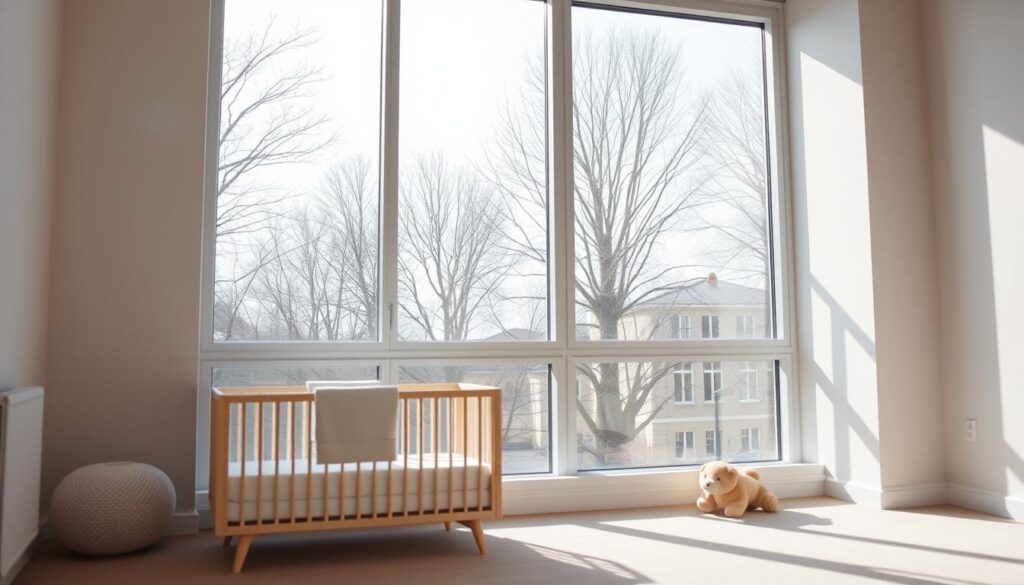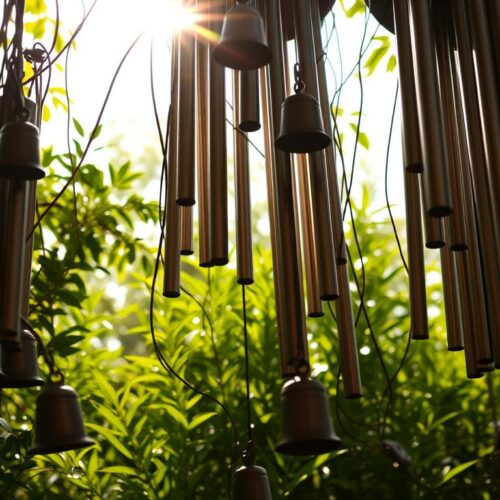Babies need good sleep for their growth and happiness. In cities, traffic noise often disrupts their rest. Making your home quiet improves their sleep greatly. Installing noise-blocking curtains helps create a peaceful sleep space for them.
Understanding Traffic Noise and Its Impact
Traffic noise is a big problem for city life quality. It comes from cars, construction, and city activities. People living in busy places fight with constant road noise. It gets into homes, more so when traffic is heavy.
This noise is really bad for babies and young kids. Studies say it messes up their sleep. Bad sleep makes them cranky, not able to focus, and may slow their growth.
We need to understand how city noise affects sleep. Then, we can find ways to lower traffic noise. Parents and caregivers can do things to help. They can make sure kids sleep in a quiet, calm place. Knowing where the noise comes from helps in finding specific ways to make homes quieter for everyone.
The Importance of a Quiet Sleeping Environment
Making sure your baby sleeps in a quiet place is key for their health. Noise can really mess up their sleep, like causing them to wake up a lot.
A sound-controlled environment keeps noise steady, which is good for solid sleep. Studies show that babies sleep better in quiet places. Thus, it’s vital to keep down outside noise from things like cars, neighbors, or home devices.
A calm setting helps babies stick to their natural sleep rhythms. Keeping noise the same means their sleep isn’t broken. For their health and growth, think about making the room soundproof or using a white noise machine.
To show why a peaceful environment matters, look at this comparison:
| Environment | Impact on Baby’s Sleep |
|---|---|
| Noisy | Frequent disruptions and fragmented sleep |
| Quiet | Uninterrupted, restful sleep |
Assessing Noise Levels in Your Home
Checking the noise in your home is key to keeping your baby’s sleep smooth. Identify the main sources of noise and how they get into sleep areas. This is the first step to finding solutions for noise.
Using decibel meters helps you know the noise level at home. This makes it easy to find where the noise comes from. After finding the noise sources, you can start looking at ways to reduce the noise.
Keeping a log of noises is also a good idea. Write down when and what types of noise bother you the most. This log helps you choose the right way to lessen the noise. For instance, window seals and thick curtains can block out traffic noise. If noise from appliances is the problem, moving them or getting quieter ones may help.
Taking steps to check noise levels and use soundproofing can really make sleep better for your baby. It helps them sleep deeply, which is important for growing up healthy.
Effective Noise Reduction Solutions
Fighting traffic noise is key to giving your baby a peaceful sleep. Installing soundproof windows is a top choice. These windows cut down outside noise a lot, making inside much quieter right away.

Noise-blocking curtains are another good option. Made from thick fabric, they soak up sound, lowering noise even more. Using these curtains with soundproof windows blocks even more noise.
If you like tech solutions, think about using electronic noise reduction devices. They send out sound waves that cancel out the noise. This adds extra protection for your baby’s quiet sleep.
Using these methods together means you’re doing everything you can to reduce noise. This creates a calm and healthy place for your baby to sleep.
Creating a White Noise Environment
Using white noise is a great way to ensure your baby sleeps without interruptions. White noise machines are key in hiding loud outside sounds. They offer soothing sounds that help your baby sleep well by blocking sudden loud noises.
Picking the perfect white noise device is important. You can find ones with sounds like rain, ocean waves, or a soft fan hum. Being able to choose the sound helps make sleep time better for your baby. Look for a machine with easy volume control, timers, and is easy to move around.
Adding white noise to bedtime routines can make a big difference in sleep quality. It creates a peaceful sound wall, keeping out noises like traffic or house sounds. Also, many babies find the steady noise comforting, similar to what they heard before being born.
A white noise environment can do wonders for improving sleep for your baby and the whole family. Not only does it make sleep time smoother, but it also helps everyone in the house feel more calm and rested.
Landscaping for Noise Reduction
Landscaping smartly can make your home much quieter by blocking out traffic noise. You can create natural barriers to keep sound away from your home.
Planting dense shrubs near your home’s edges is a great way to reduce noise. Thick bushes and trees catch the sound, stopping it from moving on. Plants like hollies, junipers, and pines are especially good at this.
Building natural berms is another smart move. A berm is a mound of soil that can be covered with grass and plants. It not only looks good but also helps block and absorb noise.
Adding water features like fountains is another trick. The gentle sound of water can cover up annoying traffic noise, making your home more peaceful.
| Landscaping Solution | Benefits |
|---|---|
| Dense Shrubbery | Absorbs and traps noise, enhances privacy |
| Natural Berms | Blocks and deflects noise, adds to landscape aesthetics |
| Water Features | Masks traffic noise, creates a calming atmosphere |
Using these landscaping methods, you can better block traffic noise. Your home will be more peaceful and welcoming.
Soundproofing Your Baby’s Nursery
Making a calm space for your baby helps their growth and happiness. Soundproofing the nursery betters the room’s sound quality. It makes sure there’s a quiet atmosphere. Using certain methods can lower outside noise. This creates a perfect sleep space for your baby.
One top way to improve nursery sound is to put up acoustic panels. These panels catch sound waves, stopping them from echoing. This cuts down on noise coming in and echoes too.
Another key method is to put mass-loaded vinyl on walls and ceilings. This heavy material acts as a shield. It blocks noise from outside. Seal gaps around windows and doors too. This helps block more noise.
Double-glazed windows or thick curtains are great for nursery windows. They keep out street sounds. Door sweeps stop noise from coming under the door. This makes a quiet place for your baby to sleep.
- Install acoustic panels
- Apply mass-loaded vinyl
- Seal gaps around windows and doors
- Use double-glazed windows
- Add thick curtains
- Install door sweeps
By using these soundproofing steps, you’ll make the nursery much quieter. This peaceful setting is great for your baby. A nursery that’s quiet from street noise means your baby can sleep better.
Upgrading Windows and Doors
Start guarding your home against outside noise by installing soundproof windows and doors with good seals. This change can greatly decrease road noise making your home quieter.
Soundproof windows and sealed doors don’t just stop noise. They better insulate your home too. This means you could save money on heating and cooling because your home stays at a comfy temperature easier.
Also, high-quality windows and doors last longer. This increases your home’s value. It’s a smart move that brings you comfort, quiet, and saves energy. Altogether, these benefits create a better living environment for your family.

When you’re ready to upgrade, look for materials known for blocking sound. Talking to a home improvement expert can help. They’ll help you choose the right options based on how much noise you want to block.
Utilizing Smart Home Technology
Modern smart home technology helps keep your baby’s nursery quiet and serene. It uses advanced noise control to watch and adjust noise levels. This way, your baby can sleep without interruptions.
Integrating noise sensors with automated actions is smart. When noise is too high, the system can close windows or tweak white noise machines. No need to do it yourself, keeping sleep sounds just right.
Smart devices can also match your child’s sleep habits. You can set them to lower noise at naptime or play soft lullabies at bedtime. This blend of tech improves comfort and boosts your baby’s sleep quality.
The data from these smart systems offers clues about noise and sleep. By looking at this info, you can upgrade noise control in the nursery. This will help your baby enjoy peaceful nights.
Community Solutions for Reducing Traffic Noise
Working together for community noise reduction is key to lowering traffic noise in cities. With the right strategies, people can have peaceful homes. The whole neighborhood will enjoy the quiet.
One top method is enforcing speed limits. Cars that move slower make less noise. This makes places quieter. Steering heavy vehicles away from calm areas also helps a lot.
Putting up sound barriers is another great approach. Walls and greenery can block and soak up sound. This action helps lower noise. Neighbors can push for these solutions in noisy spots.
Telling people about the benefits of less noise can make a big difference, too. Encouraging quieter cars and using buses or trains can cut down on noise. This helps everyone work together to keep their area quiet.
When neighborhoods try these steps, they can beat traffic noise. This creates a peaceful area for everyone to live. It’s especially good for little kids who need silence to sleep and grow well.
Temporary Solutions for Noise Management
Immediate relief from traffic noise is possible with temporary solutions. Noise-cancelling headphones offer a quick fix. They block disturbing sounds, helping you and your baby sleep peacefully.
Another easy option is temporary window inserts. They’re easy to install and cut down outside noise well. They’re not permanent, but they’re good until you can do more.
Also, moving furniture can help reduce noise. Putting heavy furniture against walls or using thick curtains can soak up sound. This makes your home quieter.
Planning for Long-Term Noise Reduction
Getting ready for long-term noise reduction needs smart planning. This means combining your own steps with efforts from the whole community. First, make your home soundproof. You can do this by insulating walls, getting double or triple-pane windows, and using solid-core doors. These changes make outside noise less of a problem and make life at home better.
On a bigger scale, being part of community planning is key to lower city noise. Getting involved in talks about noise rules and supporting projects that lessen traffic noise helps a lot. Cities like Boston and San Francisco got quieter thanks to people working together and smart city planning. Joining hands with your neighbors and city officials can make your community a calmer place.
Supporting local rules for noise control is also crucial. Push for policies that reduce speed in living areas, prefer quieter road materials, and set noise limits for building sites. By backing these actions, you’re working towards long-lasting noise solutions. This helps make sure future generations can enjoy quieter surroundings. Remember, cutting down on city noise needs both personal and group actions.




